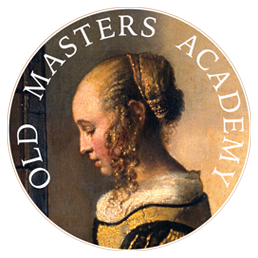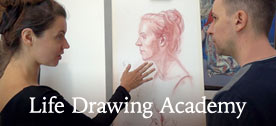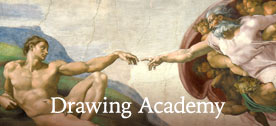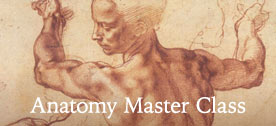Art Lesson 19, Part 1
In this lesson, you will have Oil Painting Mediums Explained
Learn how to paint like the Old Masters!
Old Masters Academy Online Course
Self-study, self-paced online video courseLifetime membershipOne-time payment: $487Enroll Now!Personal Tutoring online + Online Course
Unlimited tutoring by the Academy teachersLifetime membershipOne-time payment: $997Enroll Now!« Back to the Art Lessons List
Oil Painting Mediums Explained
The consistency of the Paint, the body of Paint dabs and the brushstrokes highly depend on the Medium we add and the quantity of it. The characteristics and effects on the paint surface could differ according to the Medium used. The surface could become rich and glossy or faded and matte. The visual character of strokes also depends the on Medium used – either strokes could hold the form and keep the tracks of the brush’s hair, or they can flow freely on all sides and organize a very smooth surface.
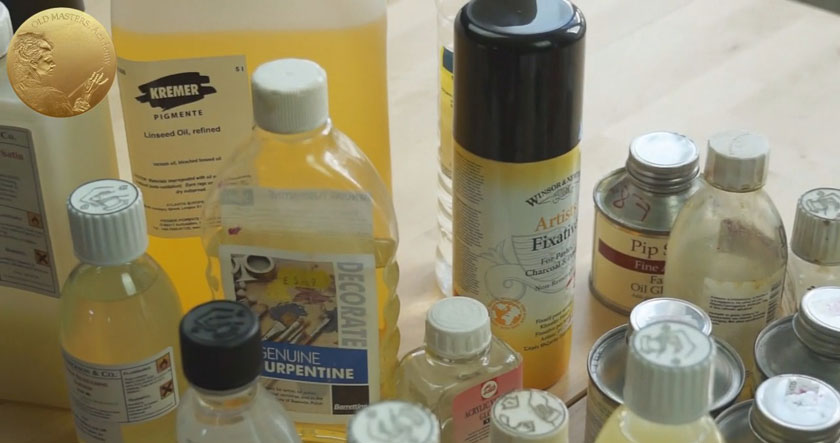
To get to know our Mediums in practice and how they influence the Paint, we will do the following test.
First, we need Worksheet #9. Outline the guidelines on the prepared support. In our case, it is an Unstretched Primed Canvas.
Well, let’s start. List all the Mediums you want to test on the left-hand side. Atop, we indicate the percentage of Paint to Medium. We used 75% of Paint to Medium and 50%, 25%, 10% and 5% of Paint to 95% of Medium, respectively.
Choose any Color you like. We have chosen Venetian Red, which is an extremely opaque and a very fast drying Paint. On the very top cell, we place the Paint in its normal condition, without any added Medium, just as it is from the tube. 100% of the Paint.
So, we can later compare our thinned and diluted Paint samples with this one, undiluted. We apply the Paint from impasto to the thinly spread layer.
Let’s start with Turpentine – a very volatile Medium. First, we admix about 25 percent of Medium to 75 percent of Paint. Of course, we measure that approximately. Then, we add more Turpentine, relying on our sense, to make the mixes more and more thinned till we get a just slightly-colored liquid as a mix of 5% of Paint to a total 95% of Turpentine.
Now, it’s time for the Linseed Oil. We are testing a plain Refined Linseed Oil. And again, we are thinning the Paint in proportions of 75% Paint to 25% Linseed Oil, and so on for 50, 25, 10 and 5 percent. You can feel the difference in the physical aspect while rendering the mixes. For example, a diluent such as Turpentine feels very watery, like a Watercolor.
Our next Medium is Linseed Stand Oil – you see how viscose the substance of this thickened Oil is. It’s not easily flowing, like plain Linseed Oil. I must say, the feeling of working with such condensed Oil is very pleasant.
Now, we proceed with the so-called Oil Glaze Medium, which is not on our List. Such kinds of manufactured Mediums usually have Resin (Dammar resin in most cases), Linseed Oil or Turpentine and drying agents as their components. There are a lot of recipes and different component combinations. Every manufacturer calls such kinds of Mediums differently; just read the label for the components. I haven’t used such Resin Mediums for years, just because I can more easily cope with the Mediums I listed previously. Besides, it gives too glossy of a surface.
One more Medium we can test here that we also didn’t include on our List is a product of Winsor & Newton called Artists’ Painting Medium. This is just Linseed Stand Oil diluted in Petroleum. We can easily prepare such Medium ourselves, using the materials from our List, and dilute Linseed Stand Oil with Turpentine or Low Odor White Spirit in any proportions we find necessary.
And finally – Liquin Original and Liquin Fine Detail, products made from artificial Alkyd Resin. We are testing them here just to see how they visually differ from other Mediums. I remind you that Liquin is a relatively new product, and we still do not know how it will behave in times to come.
What you need for the task:
- Worksheet #9
- Prepared Support – Canvas, Canvas Board or Oil Painting Paper A3
- Masking tape
- Any Oil Paint, for example Venetian Red
- All Paintings Mediums you want to test
- Hog or/and Synthetic Brush
